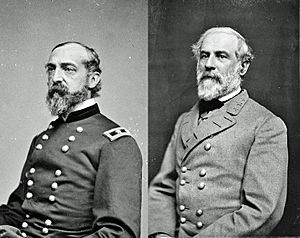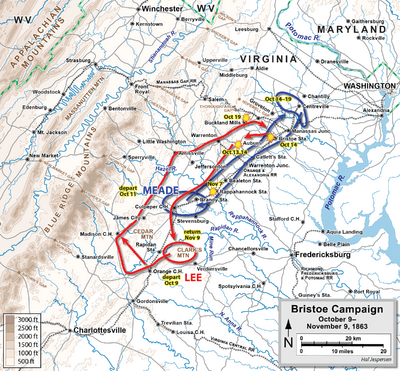Bristoe campaign facts for kids
Quick facts for kids Bristoe campaign |
|||||||
|---|---|---|---|---|---|---|---|
| Part of the American Civil War | |||||||
 George G. Meade and Robert E. Lee, commanding generals of the Bristoe campaign |
|||||||
|
|||||||
| Belligerents | |||||||
| Commanders and leaders | |||||||
| Units involved | |||||||
| Army of the Potomac | Army of Northern Virginia | ||||||
| Strength | |||||||
| 76,000 | 45,000 | ||||||
| Casualties and losses | |||||||
| 4,815 | |||||||
The Bristoe campaign was a series of small but important battles. They took place in Virginia during October and November 1863. These fights were part of the American Civil War.
Major General George G. Meade led the Union Army of the Potomac. He tried to defeat General Robert E. Lee's Army of Northern Virginia. However, Meade was not successful in his main goal.
Lee tried a clever move to get around Meade's army. This forced Meade to pull his troops back towards Centreville. On October 14, Lee attacked at Bristoe Station. But his troops suffered heavy losses and had to retreat.
As Meade moved south again, the Union army won a big victory. They broke through a Confederate defense at Rappahannock Station on November 7. This pushed Lee's army back across the Rapidan River. Besides these main battles, cavalry (horseback soldiers) also fought. They clashed at Auburn on October 13 and 14. Another cavalry battle happened at Buckland Mills on October 19.
The Confederates did not reach their main goals. They failed to force a major battle or stop Union help from going to the Western Theater. This made Lee and his officers very disappointed.
Contents
Why the Bristoe Campaign Happened
After the Battle of Gettysburg in July 1863, Robert E. Lee's army retreated. They crossed the Potomac River and went back to Virginia. Lee's troops gathered behind the Rapidan River in Orange County, Virginia.
Many people criticized Meade for not chasing Lee's army more aggressively. They felt he missed a chance to end the war sooner. So, Meade started planning new attacks in Virginia for the fall.
In early September, Lee sent two divisions of his army away. These troops, led by Lieutenant General James Longstreet, went to help the Confederate Army of Tennessee. They were needed for the Battle of Chickamauga. Meade learned that Lee's army was weaker now. He wanted to use this chance to attack.
Meade moved his army to the Rappahannock River in August. On September 13, he sent strong forces forward. They faced Lee's army along the Rapidan River. The Union army then took control of Culpeper, Virginia.
Meade planned a wide turning movement. This was similar to a plan used by Major General Joseph Hooker earlier that spring. Meade wanted to use his larger army to get around Lee's side. However, on September 24, the Union army also had to send troops away. The 11th and 12th Corps went to the Chattanooga campaign in Tennessee.
Lee soon found out about the Union troops leaving. In early October, he started his own attack. He tried to move around Meade's right side near Cedar Mountain. Meade's army was larger, but he did not want to fight in a bad position. So, he ordered the Army of the Potomac to pull back. They moved along the Orange and Alexandria Railroad line.
Key Battles of the Campaign
Auburn: Cavalry Clashes
On October 13, Major General J.E.B. Stuart was on a cavalry raid. He was trying to capture Union supply wagons. By accident, he ran into the rear guard of the Union 3rd Corps near Warrenton.
Lieutenant General Richard S. Ewell's Confederate corps was sent to help Stuart. But Stuart cleverly hid his cavalry in a wooded ravine. The Union 3rd Corps moved past without knowing he was there. So, Stuart did not need help after all.
As the Union army pulled back towards Manassas Junction, Meade was careful. He wanted to protect his western side. He remembered how Major General John Pope and Hooker had been surrounded in earlier battles.
On October 14, parts of Major General Gouverneur K. Warren's 2nd Corps fought a rear-guard action. They battled Stuart's cavalry and infantry near Auburn. Stuart's cavalry bravely tricked Warren's soldiers and escaped danger. The Union 2nd Corps then moved on to Catlett Station.
Bristoe Station: A Surprise Attack
On October 14, Lieutenant General A.P. Hill's Confederate corps found two Union corps retreating at Bristoe Station. Hill attacked without properly checking the area first.
Union soldiers from the 2nd Corps were waiting. They were hidden behind the Orange & Alexandria Railroad embankment. They badly damaged two brigades of Major General Henry Heth's division. The Union troops also captured a Confederate artillery battery. Hill sent more troops to his line, but they could not break through the strong Union defense.
After this Union victory, Meade continued his retreat to Centreville. Lee's attack at Bristoe stopped. Meade's army was well dug in, and Lee's troops were running out of supplies. After some small fights near Manassas and Centreville, the Confederates slowly pulled back. They went towards the Rappahannock River, destroying the railroad as they went.
Meade was under pressure from Major General Henry W. Halleck, the general-in-chief. Halleck wanted Meade to chase Lee. But it took almost a month to rebuild the railroad tracks for Union supplies.
Buckland Races: Cavalry Chase
After losing at Bristoe Station, Stuart's cavalry protected Lee's army. They helped Lee's troops retreat from the Manassas Junction area. Union cavalry, led by Brigadier General Judson Kilpatrick, chased Stuart's cavalry. They followed along the Warrenton Turnpike.
But Kilpatrick's troops were led into a trap near Chestnut Hill. They were completely defeated and scattered. The Union cavalry were chased for five miles. This event became known as the "Buckland Races."
Across the Rappahannock: Union Breakthrough
Lee returned to his old position behind the Rappahannock River. But he left a strong defensive position on the north bank. This protected the way to Kelly's Ford.
On November 7, Meade forced his army across the Rappahannock at two places. Major General John Sedgwick's 6th Corps launched a surprise attack at dusk. They overran the Confederate defenses at Rappahannock Station. They captured two brigades, more than 1,600 men, from Major General Jubal A. Early's division.
The fighting at Kelly's Ford was not as fierce. But the Confederates still had to retreat. This allowed the Union army to cross the river in large numbers.
What Happened Next
Lee's army was about to settle into winter camps near Culpeper. Instead, they had to retreat further into Orange County, south of the Rapidan River. The Army of the Potomac then took up positions near Brandy Station and Culpeper County.
The five battles of the Bristoe campaign caused 4,815 casualties for both sides. This included 1,973 Confederate soldiers captured at Rappahannock Station. Lee and his officers were very unhappy with their lack of success. They had failed to achieve their main goals. They could not force a decisive battle or stop Union reinforcements from going to the Western Theater.
Meade's army was in a good position. They were close to their supply base and had fewer casualties. Abraham Lincoln wanted Meade to win a major victory against Lee before winter. So, Meade began planning his Mine Run campaign for later in November.
|


